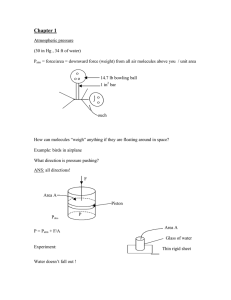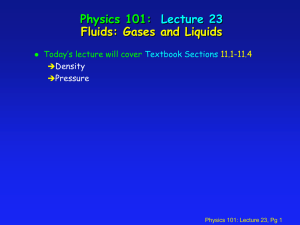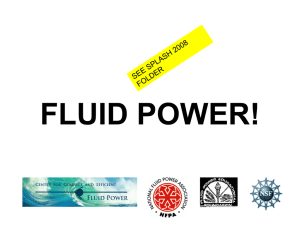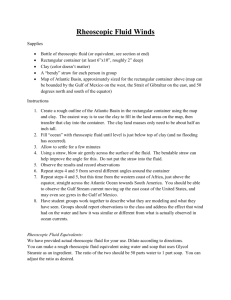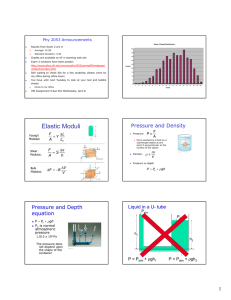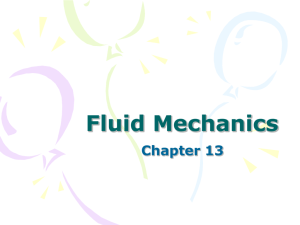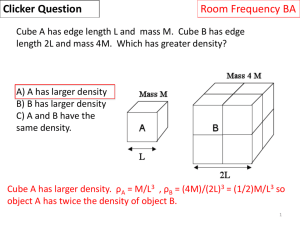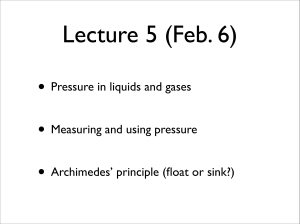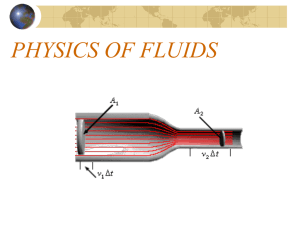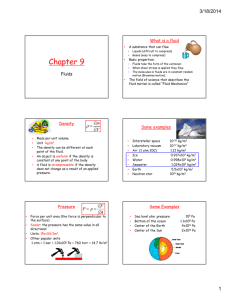Fluids 1
advertisement
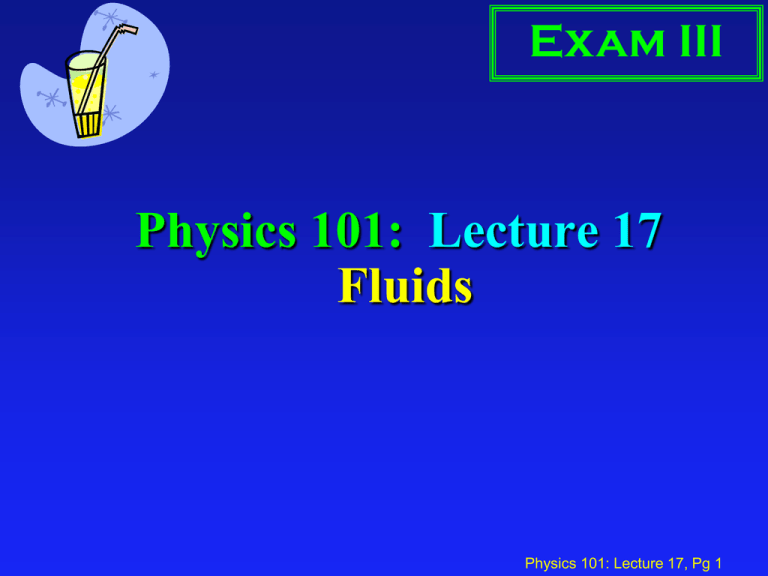
Exam III Physics 101: Lecture 17 Fluids Physics 101: Lecture 17, Pg 1 Homework Help A block of mass M1 = 3 kg rests on a table with which it has a coefficient of friction µ = 0.73. A string attached to the block passes over a pulley to a block of mass M3 = 5 kg. The pulley is a uniform disk of mass m2 = 0.7 kg and radius 15 cm. As the mass m3 falls, the string does not slip on the pulley. T3 1) T1 – f = M1a1 f M1 2) T1R – T3 R = I a2 3) T3 – M3 g = M3 a3 Notes: 1) f = m M1 g 2) a2 = -a1 / R 3) I = ½ M R2 4) a1 = -a3 T1 N Newtons 2nd Law T1 M3 m2 T3 m1g m3g y x Rewrite (a = a1) 1) T1 = M1(a+mg) 2) T3 – T1 = ½ M2 a 3) T3 = M3 (g – a) Physics 101: Lecture 17, Pg 2 10 Overview SF =ma SFx = Change in Kinetic Energy SFt = Change in momentum St =Ia Today look at application of these ideas to molecules in fluids Physics 101: Lecture 17, Pg 3 10 States of Matter Solid Hold Volume Hold Shape Liquid Fluids Hold Volume Adapt Shape Gas Adapt Volume Adapt Shape Physics 101: Lecture 17, Pg 4 11 Qualitative Demonstration of Pressure Force due to molecules of fluid colliding with container. Impulse = p Average Pressure = F / A y p y mv y average vertical force f y t t Physics 101: Lecture 17, Pg 5 16 Atmospheric Pressure Basically weight of atmosphere! Air molecules are colliding with you right now! Pressure = 1x105 N/m2 = 14.7 lbs/in2! Example: Sphere w/ r = 0.1 m Demo A = 4 p r2 = .125 m2 F = 12,000 Newtons (over 2,500 lbs)! Physics 101: Lecture 17, Pg 6 21 Pascal’s Principle A change in pressure at any point in a confined fluid is transmitted everywhere in the fluid. Hydraulic Lift P1 = P2 F1/A1 = F2 / A2 F1 = F2 (A1/A2) Compare the work done by F1 with the work done by F2 A) W1 > W2 B) W1 = W2 C) W1 < W2 W = F d cos q = F2 (A1 / A2) d1 W1 = F1 d1 = F2 V1 / A2 = F2 (A1 / A2) d1 = F2 d2 = W2 Physics 101: Lecture 17, Pg 7 26 Gravity and Pressure Two identical “light” containers are filled with water. The first is completely full of water, the second container is filled only ½ way. Compare the pressure each container exerts on the table. 1 A) P1 > P2 B) P1 = P2 2 C) P1 < P2 P = F/A = mg / A Cup 1 has greater mass, but same area Under water P = Patmosphere + r g h Physics 101: Lecture 17, Pg 8 30 Dam ACT B A A Two dams of equal height prevent water from entering the basin. Compare the net force due to the water on the two dams. A) FA > FB B) FA=FB C) FA< FB F = P A, and pressure is rgh. Same pressure, same area same force even though more water in B! Physics 101: Lecture 17, Pg 9 33 Pressure and Depth Barometer: a way to measure atmospheric pressure For non-moving fluids, pressure depends only on depth. p1=0 p2 = p1 + rgh Patm - 0 = rgh p2=patm h Measure h, determine patm example--Mercury r = 13,600 kg/m3 patm = 1.05 x 105 Pa h = 0.757 m = 757 mm = 29.80” (for 1 atm) Physics 101: Lecture 17, Pg 10 35 Preflight Is it possible to stand on the roof of a five story (50 foot) tall house and drink, using a straw, from a glass on the ground? Pa p=0 Pa rgh h 60% 1. No rg pa h 40% 2. Yes Even if a person could remove all the air from the straw, the height to which the outside air pressure moves the water up the straw would not be high enough for the person to drink the water. What a cool situation-it must be possible. I mean we don't know how really tall trees get water all the way up to their highest leaves, but they obviously do, so this must also be possible. Physics 101: Lecture 17, Pg 11 40 Archimedes’ Principle Determine force of fluid on immersed cube Draw FBD » FB = F2 – F1 » = P2 A – P1 A » = (P2 – P1)A » =rgdA » =rgV Buoyant force is weight of displaced fluid! Physics 101: Lecture 17, Pg 12 43 Fb Archimedes Example A cube of plastic 4.0 cm on a side with density = 0.8 g/cm3 is floating in the water. When a 9 gram coin is placed on the block, how much does it sink below the water surface? SF=ma Mg mg h Fb – Mg – mg = 0 r g Vdisp = (M+m) g Vdisp = (M+m) / r h A = (M+m) / r M = rplastic Vcube = 4x4x4x0.8 = 51.2 g h = (M + m)/ (r A) = (51.2+9)/(1 x 4 x 4) = 3.76 cm Physics 101: Lecture 17, Pg 13 49 Summary Pressure is force exerted by molecules “bouncing” off container P = F/A Gravity/weight affects pressure P = P0 + rgd Buoyant force is “weight” of displaced fluid. F = r g V Physics 101: Lecture 17, Pg 14
